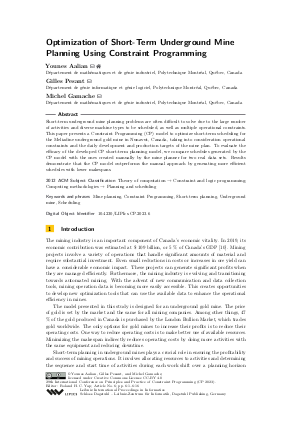Optimization of Short-Term Underground Mine Planning Using Constraint Programming
Authors Younes Aalian, Gilles Pesant, Michel Gamache
-
Part of:
Volume:
29th International Conference on Principles and Practice of Constraint Programming (CP 2023)
Part of: Series: Leibniz International Proceedings in Informatics (LIPIcs)
Part of: Conference: International Conference on Principles and Practice of Constraint Programming (CP) - License:
 Creative Commons Attribution 4.0 International license
Creative Commons Attribution 4.0 International license
- Publication Date: 2023-09-22
File

PDF
LIPIcs.CP.2023.6.pdf
- Filesize: 3.12 MB
- 16 pages
Document Identifiers
Subject Classification
ACM Subject Classification
- Theory of computation → Constraint and logic programming
- Computing methodologies → Planning and scheduling
Keywords
- Mine planning
- Constraint Programming
- Short-term planning
- Underground mine
- Scheduling
Metrics
- Access Statistics
-
Total Accesses (updated on a weekly basis)
0PDF Downloads0Metadata Views
Abstract
Short-term underground mine planning problems are often difficult to solve due to the large number of activities and diverse machine types to be scheduled, as well as multiple operational constraints. This paper presents a Constraint Programming (CP) model to optimize short-term scheduling for the Meliadine underground gold mine in Nunavut, Canada, taking into consideration operational constraints and the daily development and production targets of the mine plan. To evaluate the efficacy of the developed CP short-term planning model, we compare schedules generated by the CP model with the ones created manually by the mine planner for two real data sets. Results demonstrate that the CP model outperforms the manual approach by generating more efficient schedules with lower makespans.
Cite As Get BibTex
Younes Aalian, Gilles Pesant, and Michel Gamache. Optimization of Short-Term Underground Mine Planning Using Constraint Programming. In 29th International Conference on Principles and Practice of Constraint Programming (CP 2023). Leibniz International Proceedings in Informatics (LIPIcs), Volume 280, pp. 6:1-6:16, Schloss Dagstuhl – Leibniz-Zentrum für Informatik (2023)
https://doi.org/10.4230/LIPIcs.CP.2023.6
BibTex
@InProceedings{aalian_et_al:LIPIcs.CP.2023.6,
author = {Aalian, Younes and Pesant, Gilles and Gamache, Michel},
title = {{Optimization of Short-Term Underground Mine Planning Using Constraint Programming}},
booktitle = {29th International Conference on Principles and Practice of Constraint Programming (CP 2023)},
pages = {6:1--6:16},
series = {Leibniz International Proceedings in Informatics (LIPIcs)},
ISBN = {978-3-95977-300-3},
ISSN = {1868-8969},
year = {2023},
volume = {280},
editor = {Yap, Roland H. C.},
publisher = {Schloss Dagstuhl -- Leibniz-Zentrum f{\"u}r Informatik},
address = {Dagstuhl, Germany},
URL = {https://drops.dagstuhl.de/entities/document/10.4230/LIPIcs.CP.2023.6},
URN = {urn:nbn:de:0030-drops-190430},
doi = {10.4230/LIPIcs.CP.2023.6},
annote = {Keywords: Mine planning, Constraint Programming, Short-term planning, Underground mine, Scheduling}
}
Author Details
- Département de mathématiques et de génie industriel, Polytechnique Montréal, Québec, Canada
- Département de génie informatique et génie logiciel, Polytechnique Montréal, Québec, Canada
References
-
Max Åstrand, Mikael Johansson, and Jenny Greberg. Underground mine scheduling modelled as a flow shop: a review of relevant work and future challenges. Journal of the Southern African Institute of Mining and Metallurgy, 118(12):1265-1276, 2018.

-
Max Åstrand, Mikael Johansson, and Alessandro Zanarini. Fleet scheduling in underground mines using constraint programming. In Integration of Constraint Programming, Artificial Intelligence, and Operations Research: 15th International Conference, CPAIOR 2018, Delft, The Netherlands, June 26-29, 2018, Proceedings 15, pages 605-613. Springer, 2018.

-
Max Åstrand, Mikael Johansson, and Alessandro Zanarini. Underground mine scheduling of mobile machines using constraint programming and large neighborhood search. Computers & Operations Research, 123:105036, 2020.

-
Philippe Baptiste, Claude Le Pape, and Wim Nuijten. Constraint-based scheduling: applying constraint programming to scheduling problems, volume 39. Springer Science & Business Media, 2001.

-
Louis-Pierre Campeau and Michel Gamache. Short-term planning optimization model for underground mines. Computers & Operations Research, 115:104642, 2020.

-
Louis-Pierre Campeau and Michel Gamache. Short-and medium-term optimization of underground mine planning using constraint programming. Constraints, 27(4):414-431, 2022.

-
Louis-Pierre Campeau, Michel Gamache, and Rafael Martinelli. Integrated optimisation of short-and medium-term planning in underground mines. International Journal of Mining, Reclamation and Environment, 36(4):235-253, 2022.

-
Atlas Copco. Mining methods in underground mining. Atlas Copco: Nacka, Sweden, 2007.

-
Philippe Laborie, Jérôme Rogerie, Paul Shaw, and Petr Vilím. Ibm ilog cp optimizer for scheduling: 20+ years of scheduling with constraints at ibm/ilog. Constraints, 23:210-250, 2018.

-
B. Marshall. Facts and figures : The state of canada’s mining industry. Technical report, The Mining Association of Canada, 2020.

-
Micah Nehring, Erkan Topal, and Peter Knights. Dynamic short term production scheduling and machine allocation in underground mining using mathematical programming. Mining Technology, 119(4):212-220, 2010.

-
Dónal O’Sullivan and Alexandra Newman. Optimization-based heuristics for underground mine scheduling. European Journal of Operational Research, 241(1):248-259, 2015.

-
Marco Schulze and Jürgen Zimmermann. Staff and machine shift scheduling in a german potash mine. Journal of Scheduling, 20:635-656, 2017.

-
Cinna Seifi, Marco Schulze, and Jürgen Zimmermann. A two-stage solution approach for a shift scheduling problem with a simultaneous assignment of machines and workers. In Mining Goes Digital, pages 377-385. CRC Press, 2019.

-
Zhen Song, Håkan Schunnesson, Mikael Rinne, and John Sturgul. Intelligent scheduling for underground mobile mining equipment. PloS one, 10(6):e0131003, 2015.

-
Farzad Sotoudeh, Micah Nehring, Mehmet Kizil, Peter Knights, and Amin Mousavi. Production scheduling optimisation for sublevel stoping mines using mathematical programming: A review of literature and future directions. Resources Policy, 68:101809, 2020.

-
Hao Wang, Victor Tenorio, Guoqing Li, Jie Hou, and Nailian Hu. Optimization of trackless equipment scheduling in underground mines using genetic algorithms. Mining, Metallurgy & Exploration, 37:1531-1544, 2020.

